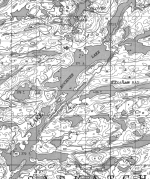When I paddled the Yukon River, I did not need detailed topographiic information, only the most recently available river channel iand island location information. So I downloaded imagery from Google Earth which had 2-3 year old map images, since the river channels change almost annually. I cropped the images to approximate ten mile segments and printed on regular computer paper. It took 95 sheets to cover the 1000 mile race route. You can choose to overlay coordinate information lines on the maps as well, which I did not necessarily need on all of them.
I then layed out the 95 pages on my garage floor and spray coated both sides with a fairly cheap waterproof spray from Walmart. I then put each page in a protective plastic sleeve and collected then all in a 3-ring binder. They have survived more than one trip down the Yukon River, even after getting wet in the bottom of my canoe.
In the past I have used Thomson's Water Seal as well with great success on topo maps. Not only does it waterproof, iit also makess the paper somewhat resistant to tearing. Just be sure to use the more liquid variety of TWS, not the gel, as that will darken white paper.

